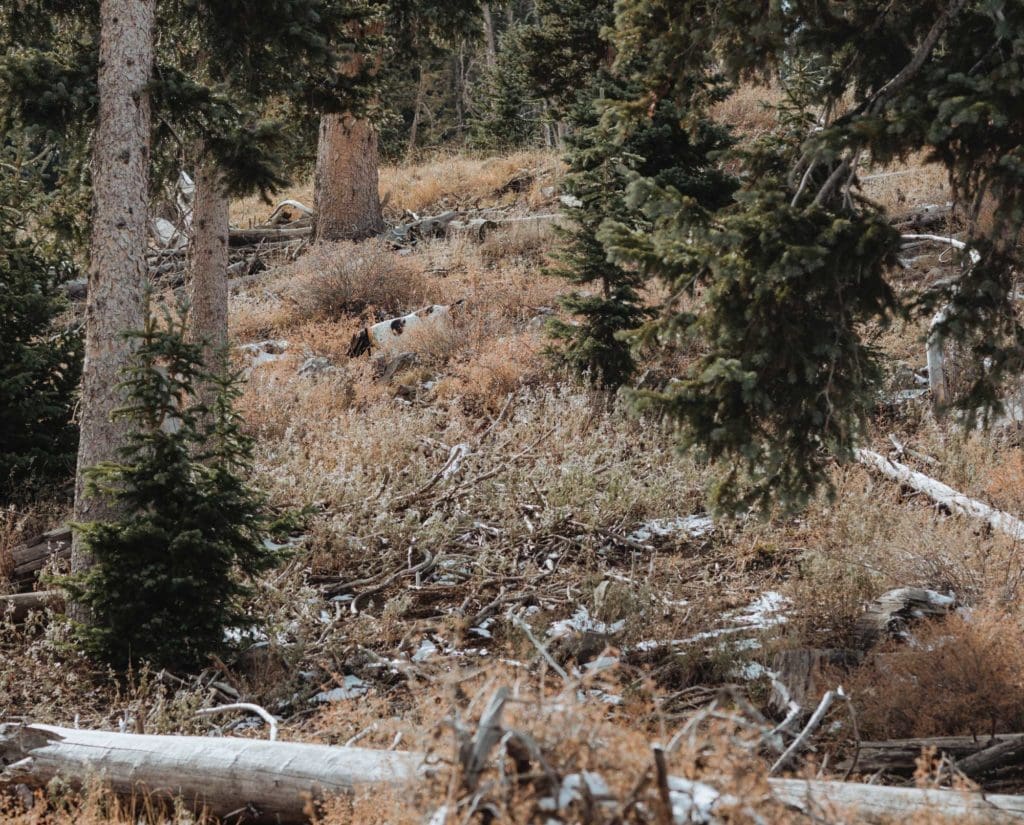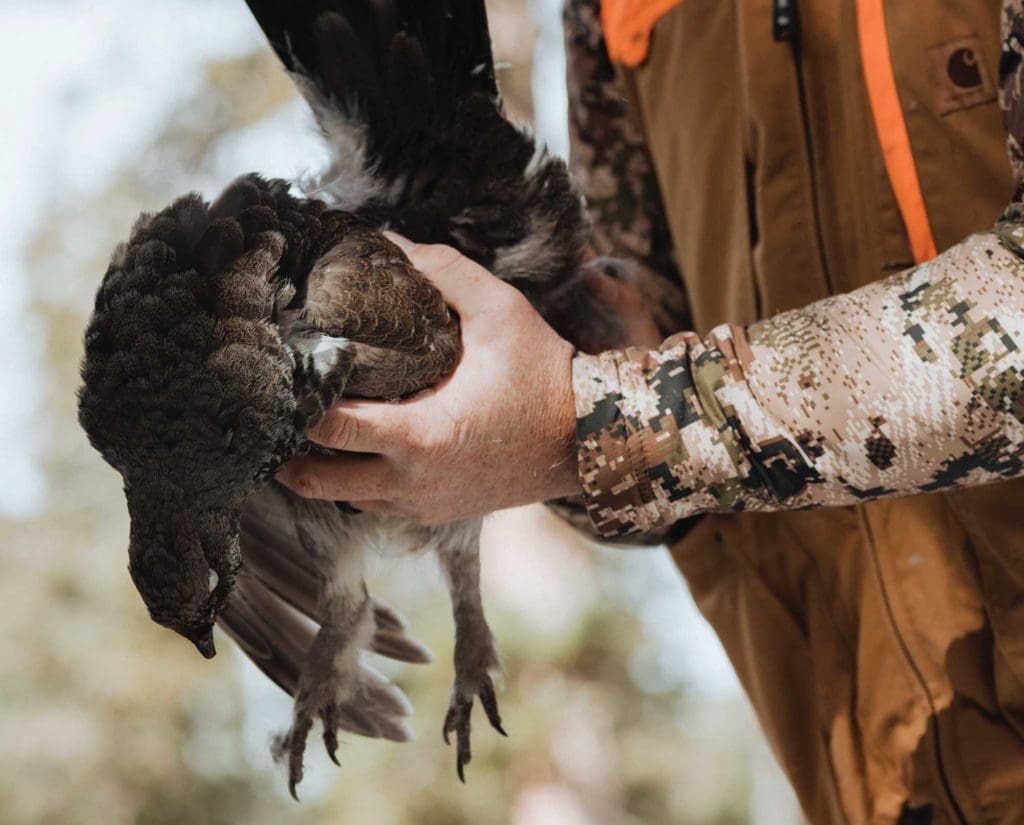Home » Grouse Species » Blue Grouse Hunting » A Guide to Hunting Blue Grouse in North America
A Guide to Hunting Blue Grouse in North America

Josh Tatman is from northern Wyoming. He is passionate about…
Blue Grouse Offer Unique High Elevation Hunting Opportunities in America’s Western Mountains
The wind sighed through the spruces as I closed my tailgate and headed down the ridgeline. My dog, Bailey, and I walked along following a faint trail cleared by elk hooves. We dripped through small glades of evergreens illuminated by the morning sun.
Listen to more articles on Apple | Google | Spotify | Audible
A half-mile in, Bailey paused. She sniffed through the dry September grass. Her tail started wagging. She meandered around the meadow’s edge before returning to her starting point. The scent was gone. I turned, taking a few steps down the trail.
Suddenly, a spruce exploded two feet from my head.
I yelped and jumped back. The bird blended in perfectly with the shadows along the treeline. Despite this, I composed myself, swung through the bird, and pulled the trigger. Bailey and I paused to sit, admire our prize, and relish in the cool morning air.
Blue Grouse in the West
If you spend any length of time in the high country of the American West, you are likely to be startled by a flushing dusky grouse. Their range stretches several thousand miles and covers millions of acres. Despite their wide distribution and healthy populations, these birds are overlooked by many wingshooters.
Cool mornings in the mountains are a delicious respite from the sweltering late-summer prairies. During blue grouse seasons, dogs are safe from heat and rattlesnakes. Plus, dramatic vistas in grouse habitat make for memorable hunts. With these advantages, it’s surprising that more wingshooters don’t pursue blues. I believe it’s due to their unflattering reputation.
Blue grouse are colloquially known as mountain grouse, pine hens, or fool birds; they’re often thought to be witless. Sometimes, they hold very tight, allowing humans to approach within a few yards before flushing. During mating displays, males are comically resolute. Elk hunters and campers often shoot them on the ground.
However, their reputation is only partially deserved. These birds become far more wary with dogs on the ground. Clearly, they evolved to avoid canids and big cats, not humans. If you want a sporting hunt for dusky grouse, a dog is all you need to make it interesting.
In 2006, taxonomists recognized distinct genetic and morphological variability in two major groups of blue grouse. They renamed the birds of the interior Rockies dusky grouse (Dendragapus obscurus), and named the occupants of the coastal mountains sooty grouse (Dendragapus fuliginosus). Within each species, multiple subspecies are recognized.
While they no longer officially share the blue grouse moniker, dusky grouse and sooty grouse share many habits and habitats. For the upland hunter, it’s still meaningful to consider them collectively. Besides, most western hunters still prefer to call them blues.
Blue Grouse Range
Few native upland birds rival blue grouse in distribution. They occupy every western state and province. Duskies range from Alberta all the way down the spine of the Rockies. They are common throughout the mountains of Montana, Wyoming, Idaho, Utah, Nevada, and Colorado, but trickle out in central New Mexico and Arizona. Further west, sooties are common in southern Alaska, British Columbia, Washington, and Oregon. Their range follows the Sierras all the way to southern California.
This means that for most western wingshooters, there’s likely blue grouse close to home. For traveling hunters, there’s a myriad of destinations that will provide a taste of chasing these mountain birds.
Oftentimes, blues live near other native grouse species. For example, in Wyoming, their habitat overlaps with sage grouse. In Montana and Idaho, ruffed grouse hunting covers blend into blue grouse woods. Colorado’s blues live near native populations of white-tailed ptarmigan.
Blue Grouse Biology
Blue grouse are sizable birds. Mature males weigh up to three pounds; that’s only slightly smaller than a pheasant. In fact, in North America, sage grouse are the only native upland bird that’s larger. Interestingly, biologists think sage grouse are the nearest living relatives of blue grouse.
Both the dusky and sooty species are recognized by their dark gray feathers. Males have lighter gray chests, while females are a mottled gray-brown. Some subspecies of duskies (D. o. richardsonii and D. o. pallidus, for example) have nearly solid dark gray tail feathers with an almost imperceptible lighter band at the tips. The other subspecies have a pale gray band at the tip of the tailfeathers. Sooty grouse share this coloration, making them a bit difficult to differentiate.

During mating displays, males inflate air sacs on their necks to create low hooting calls. In sooty grouse, these air sacs are a bright yellow. Dusky grouse have purple air sacks. Both species also have bright yellowish-orange combs above their eyes that enlarge during mating displays.
In the spring, male blue grouse choose audibly prominent roosts. They fan out their tail feathers and strut, making repeated low, almost subsonic hoots. They also make short “drumming flights,” fluttering their wings loudly like ruffed grouse.
Blue Grouse Habitat
Dusky and sooty grouse have very diverse warm season diets. Seeds, every sort of berry you encounter in the woods, insects, and greens are all fair game. This makes narrowing down good habitat difficult. It’s easier to focus on their cold season food sources. Blues are conifer obligates. Through the cold winter months, they roost in evergreens and eat almost nothing but needles. They are especially fond of fir needles.
Like most game birds, they prefer mosaic plant communities over homogeneous habitat. Prime winter habitat is mixed mature conifer stands atop prominent mountain ridges, extending up to treeline. The elevations of these habitats change across their range, so it’s more productive to look for the right combination of plant communities and topography.
Much has been made of the “reverse migration” of blue grouse. Oftentimes, they will mate and raise broods low on mountainsides, then migrate thousands of vertical feet up to their winter roosts by fall. However, this is likely a journey of necessity, not preference.

Hens need grassy meadow margins to raise their broods. These zones tend to have more grasshoppers and other insects that are critical for juvenile birds to fatten up before winter. Green forbs are also more prevalent along small streams lower on the mountainsides. In steep, heavily timbered mountain ranges, the classic reverse migration plays out predictably. In other mountains, even the high ridges have productive grassy glades and meadows. Oftentimes birds are more sedentary in these areas.
Hens and their broods often “surf the wave” of insects and forbs up in elevation during the summer. Mature male blue grouse usually make the vertical migration sooner. This means that a hunter can target higher elevation zones in order to avoid harvesting hens.
Hunting Blue Grouse
Blue grouse hunting seasons vary across their range, but essentially consist of the September to October timeframe. Some states have seasons that last much longer, but after the late fall snows set in, blues become hard to find. They retreat to their roosts in evergreen boughs, rarely hopping down to forage on the ground. In addition, mountain roads become drifted over with deep snow, making access much more difficult. Alaska is the only state that allows hunters to pursue sooty grouse during the spring hoot.
Any shotgun will work for blue grouse, but a light sub-gauge is ideal. Choose shotshells with ¾ to 1 ounce loads of low velocity 6 or 7 shot. Skeet or improved cylinder chokes will cover birds that flush close and far. While they are strong, fast fliers, blues are relatively easy to knock down and to find on the forest floor. Many states also allow harvest with a rimfire rifle or bow.
Just like other upland species, pressured birds become far more wary and are likely to offer challenging, fleeting shots. Half of the time, they fly long, sailing off a mountainside in thick timber. The rest of the time they flutter up to land high in a tree. Those who resist the temptation to shoot them sitting will have a rewarding wingshooting experience.

As mentioned, a good bird dog simultaneously makes blue grouse wingshooting more fun and more difficult. Big-running pointing breeds are increasingly popular, but their speed and range can be marginally useful for blues. Even a careful pointer can crowd a wise old blue before the hunter even catches a glimpse. However, close-working pointers and well-trained flushers are a joy on blue grouse.
Some blue grouse covers are easily accessible from Forest Service roads. Others require challenging hikes up and down thousands of vertical feet. Be prepared for emergencies with warm layers, a first aid kit, and plenty of food and water. Most blue grouse hunting occurs on federal or state forest land, but pay attention to land ownership.
Once you identify good habitat, strategize your route. Work meadow edges and steep slopes with small, grassy glades amongst mature conifer groves. Look for dust bath scrapes and droppings on the ground. If you find sign, but no birds, try moving a short distance into the shadowy timber. Follow small trickle creeks up and downslope, as these are vertical travel corridors. If you spot a bird on the ground, try to get below it, as blues usually try to flush downslope.
If you are lucky enough to bag a few, you are in for a treat. Blues are great table fare. If you aren’t sold on the hunting, a tender, roasted blue grouse will convince you to return to the mountains as soon as possible.
Blue Grouse Conservation
While blue grouse populations are currently considered secure through much of their range, their populations are likely declining in some areas. Southwestern dusky grouse are suffering from significant habitat loss. Recent large-scale wildfires have threatened to extirpate these regal birds from some mountain ranges in New Mexico and Arizona.
Most state game agencies don’t monitor blue grouse population trends outside of voluntary hunter surveys. This makes it difficult to say if particular populations are at risk. Like other upland species, habitat limitations are more impactful than hunting harvests. Nevertheless, blue grouse are never particularly numerous. Wise hunters will only harvest a few birds from any particular cover in order to reduce their impact.
Hunters can also help blue grouse by advocating for good forest management practices. Controlled burns, small wildfires, and strategic logging all promote healthy forest succession. In addition, careful management of livestock grazing prevents degradation of mountain riparian areas and meadows, protecting critical brood-rearing habitat.
Blue Grouse Offer a Unique Western Hunt
Blue grouse offer a unique hunting experience not to be missed. Blues are as difficult or accessible as you choose; hunt them on an afternoon stroll, or plan a multi-day grouse camp sufferfest. Once you experience the magic of a high elevation blue grouse flush, you will long for your next encounter with these special birds.
Josh Tatman is from northern Wyoming. He is passionate about conserving the last remaining wild places and the creatures that call them home.




If you want a try at these challenging birds, get your best hunting shoes on and prepare for a strenuous hike. Best to get up to elevations near and above 10000′.
I’m changing the name of our annual grouse camp to “Multi-day grouse camp sufferfest”.